Following on my first installment about Yosemite, here’s Part II.
Chapter 3: Half Done
When my alarm sounded at 4am, I looked at Half Dome and spotted two climbers several hundred feet up the Regular Northwest Face, each wearing headlamps. While they’d asked for permission to ascend the rope that Jeff and I had fixed the previous day, I still felt irritated that they’d gotten so far ahead of us thanks to our work.
We had a lot of climbing to do. Big Sandy Ledge, where we planned to next sleep, was 1,500 feet above us. To get there, we needed to ascend 17 pitches with an average difficulty of 5.9, which included several rope swings (literally, swinging 15-feet sideways on a rope to reach a hold) and one rope toss (tossing one end of the rope into a crack about 15 feet away). We each carried a paper copy of the following topo for our route:

To sustain us for the next 48 hours, we each carried about 8 liters of water — which was about half of the weight in each of our 30lb packs. As the leader for the starting pitches, I also wore 20lbs of climbing gear around my waist — meaning I had a total of 50lbs additional weight. It was like trying to climb with an air conditioner strapped to my back.
Lingering in the background of all this was a rumor about several recent deaths on El Capitan, and the shock was still reverberating through the valley. The previous morning, while we were hiking toward Half Dome, two hiker-tourists had spotted us with our gear and said, “But didn’t you hear about the people who died?” Then in the evening, while chatting with Greg and Cameron at the base of the climb, they’d told us that two men had in fact died a day earlier while speed-climbing the Salathé Wall. Adding to the tension for Jeff and I, we’d also discovered that just because we could free climb 5.10 outdoors on the East Coast didn’t mean that our abilities would readily transfer west to Yosemite. We faced the climb of our lives.
By 4:45am, I was jugging up our line using a set of jumars (which look like handles that latch onto a rope) and a set of aid ladders (which look like flimsy fabric ladders). The temp was around 50 degrees F, so I wore a long-sleeved shirt. Quickly though, I was pouring sweat, as I clumsily struggled up the rope. I’d only aid-climbed twice before: the previous day, and in Connecticut a month earlier.
Greg and Cameron started after me but soon passed me. By the time Jeff reached me 260 feet up, Greg and Cameron were out of sight above us. Behind us, the shadow of Half Dome loomed over the valley. We were in a race against time.
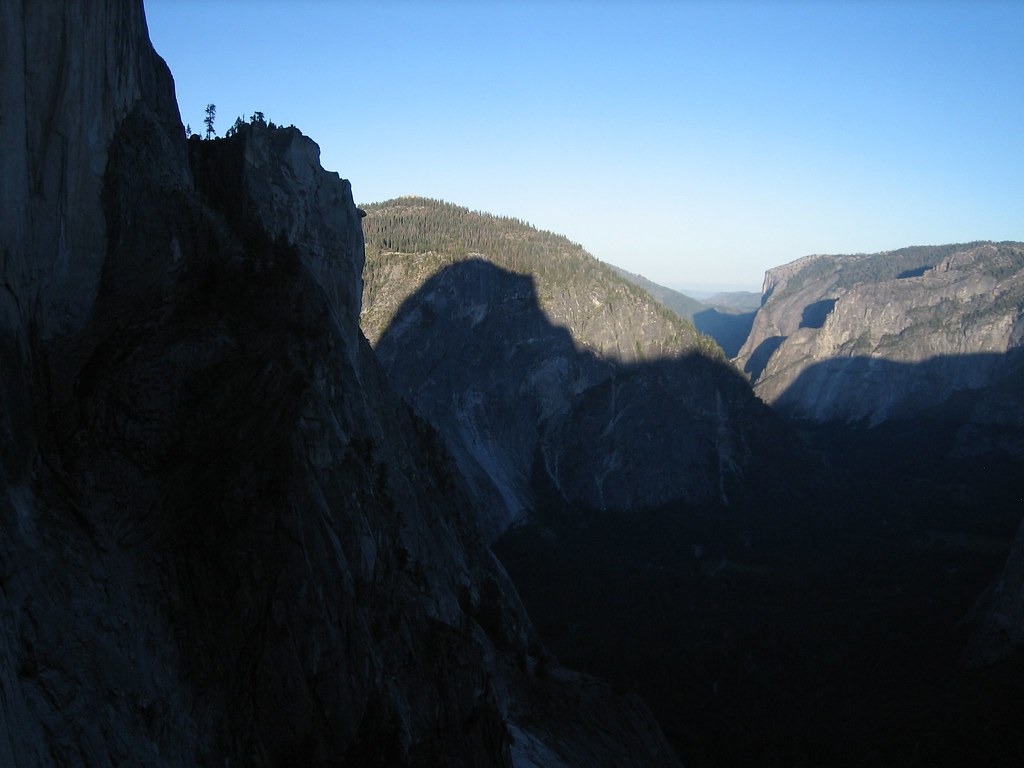
I free-climbed the third pitch: 105 feet, graded 5.8. (Six months earlier, according to The Sharp End podcast, a climber had slipped on this pitch, fallen 60 feet, broken his back, and required being airlifted off the mountain.) We finished the pitch within an hour and were on pace to reach Pitch 7 before 11am, which we had decided the previous evening would be our deadline — or else we’d quit and rappel back down.
Jeff led the fourth pitch, 110 feet and graded 5.10a or C1. He immediately took out his aid ladders and moved slowly through a roof, placing a series of nuts and cams into the cracks, allowing himself to artificially ascend the rock — he was being cautious, though perhaps overly so, placing so many pieces of gear that he was losing precious time.
Thirty minutes passed. Jeff reached a bolt ladder. Another 30 minutes passed. He reached a crack and slowly advanced, standing on his aid ladders and pulling on gear. He began taking long breaks to catch his breath. Ninety minutes passed. He took another minutes-long break.
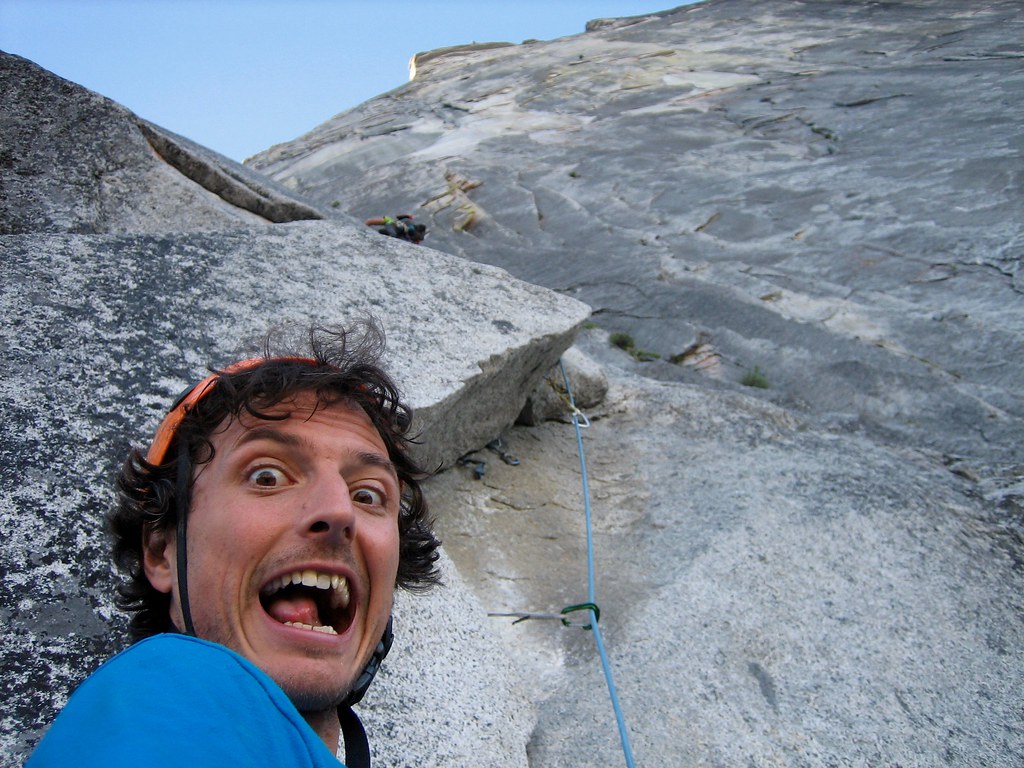
“You can rest at the top!” I yelled. “You gotta move faster!”
“I have to catch my breath,” he said — reminiscent of what he’d said the previous day during our ascent of the Death Slabs. He was feeling the effects of being 7,000-feet elevation above sea level.
Looking at my watch, I could see Half Dome slipping away. After nearly two hours, Jeff reached the end of Pitch 4. I followed in about 20 minutes. It was 9:30am. We had two more pitches to climb before the 11am cutoff.
I led Pitch 5: 100 feet, graded 5.9. It took me about 45 minutes, and Jeff followed in 15. We were now about 600 feet above the base of the route and 4,000 feet above the valley floor.
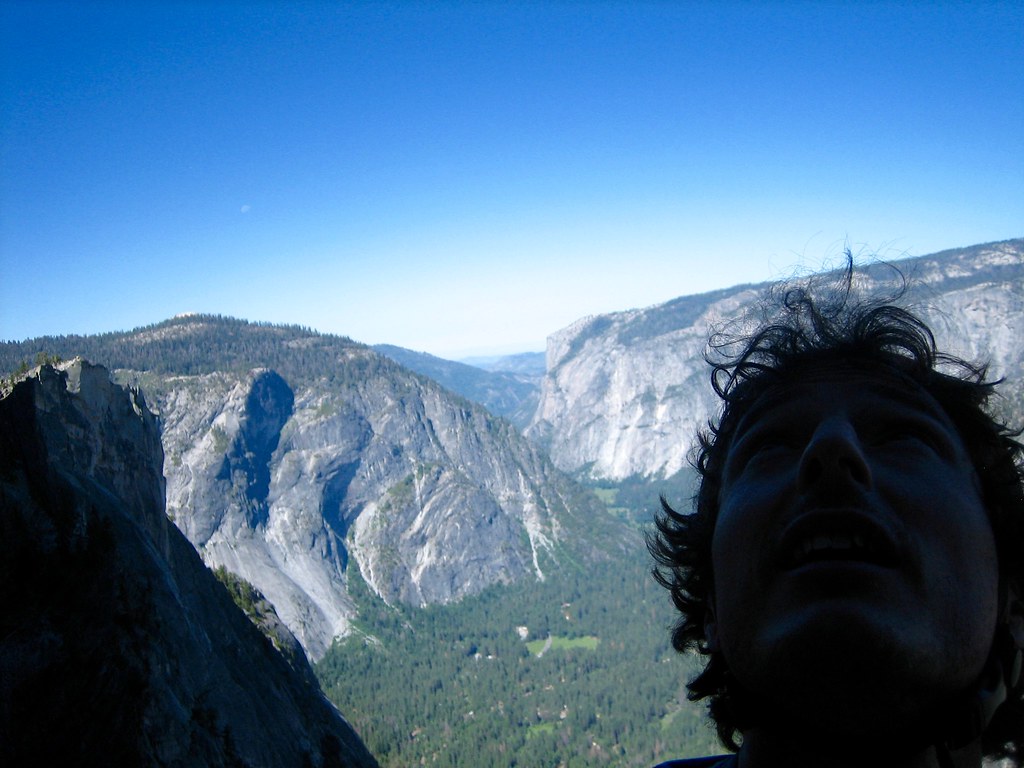
Jeff led Pitch 6: 145 feet, graded 5.8 and 5.9. Here, everything fell apart. About 20 feet up, as Jeff was setting a nut in a crack, he dropped a carabiner holding our armory of wired nuts — about eight of them, and almost essential to complete the remaining 1,500 feet of the route. Time slowed as I watched the carabiner float down, hit a ledge, and bounce into the abyss.
“Sorry man,” Jeff said, looking back at me.
“I have a feeling we’re heading in the same direction,” I said.
Chapter 4: The Retreat
Our fate was sealed by the reality of our slow ascent, even despite the dropped gear.
By the time we finished Pitch 6, it was about 11:30am — a half-hour past our self-imposed deadline and hours behind our ETA. At our speed, we were on pace to reach Big Sandy Ledge around midnight, which would mean at least three hours of climbing and route-finding in the dark. Given Jeff’s exhaustion, and our expectation that he’d lead several pitches of chimneys (which only he had previous experience climbing), we faced a scenario in which we’d likely have to emergency bivvy somewhere before Big Sandy. I suggested that we could potentially bivvy here at the base of Pitch 7 for a night, but Jeff demurred. We agreed to bail, although even this wouldn’t be so simple.
Jeff began rappeling down the sixth pitch.
“Dude, your bag!” I yelled, pointing to his backpack, which was still hanging on the anchor beside me.
“Just slide it down,” he suggested
“Are you crazy?” I said in so many words. “I’m not going to slide a 30lb bag down 15 feet of rope so it slams into you when you’re standing 600 feet above the ground.”
Jeff pulled himself back up the rappel to retrieve his bag. Our rope didn’t reach the bottom of the sixth pitch, so he built an anchor above 20 feet above it. After I rappelled down to him, he then rappelled to the bottom of the pitch. I then cleaned the anchor and down-climbed those 20 feet. It was all somewhat tricky and very time-consuming.
As we continued rappelling down, our rope repeatedly got stuck. Moreover, our nerves were frayed from trusting somewhat sketchy anchor systems with who-knows-how-old slings and rings.
After nearly three hours, we were on the ground. It was 2:30pm. We collapsed in the shade and thought through options. I suggested we might retry the route the next day, either with a plan of bivvying twice on the Northwest Face or of waking earlier to give us more time to reach Big Sandy; Jeff vetoed both ideas. We decided to return to the valley via the 10-mile hiker trail.
Before departing, I craned my neck backward and, straining my eyes against the sun’s glare, saw Greg slowly climbing through the chimneys around Pitch 12.
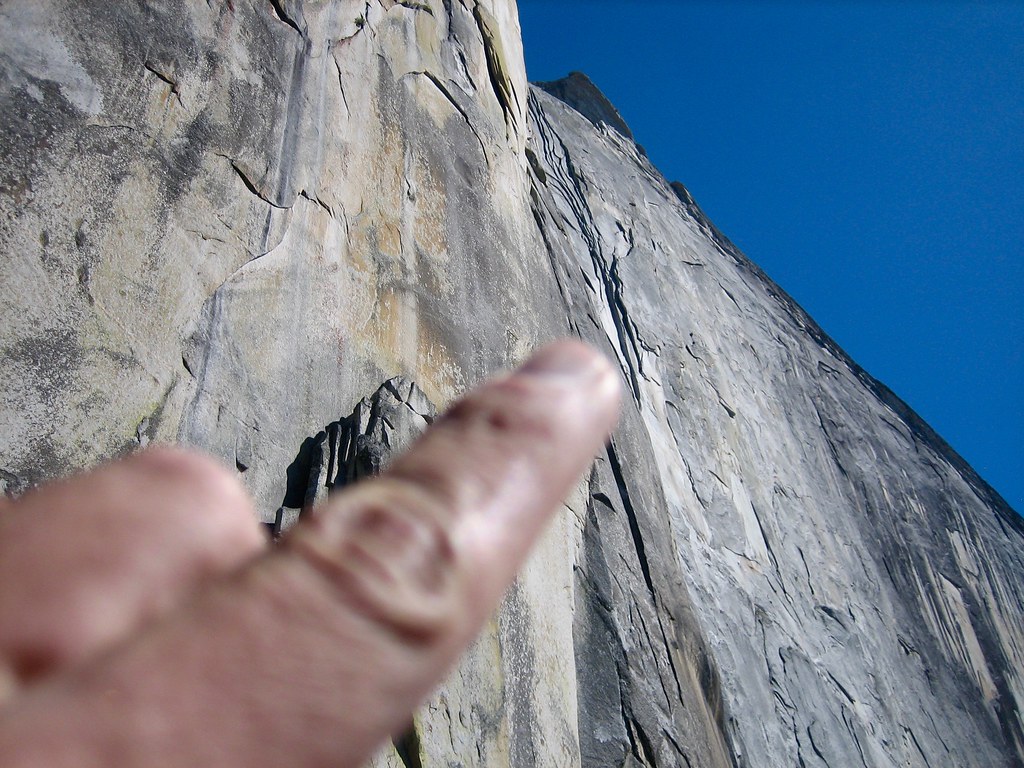
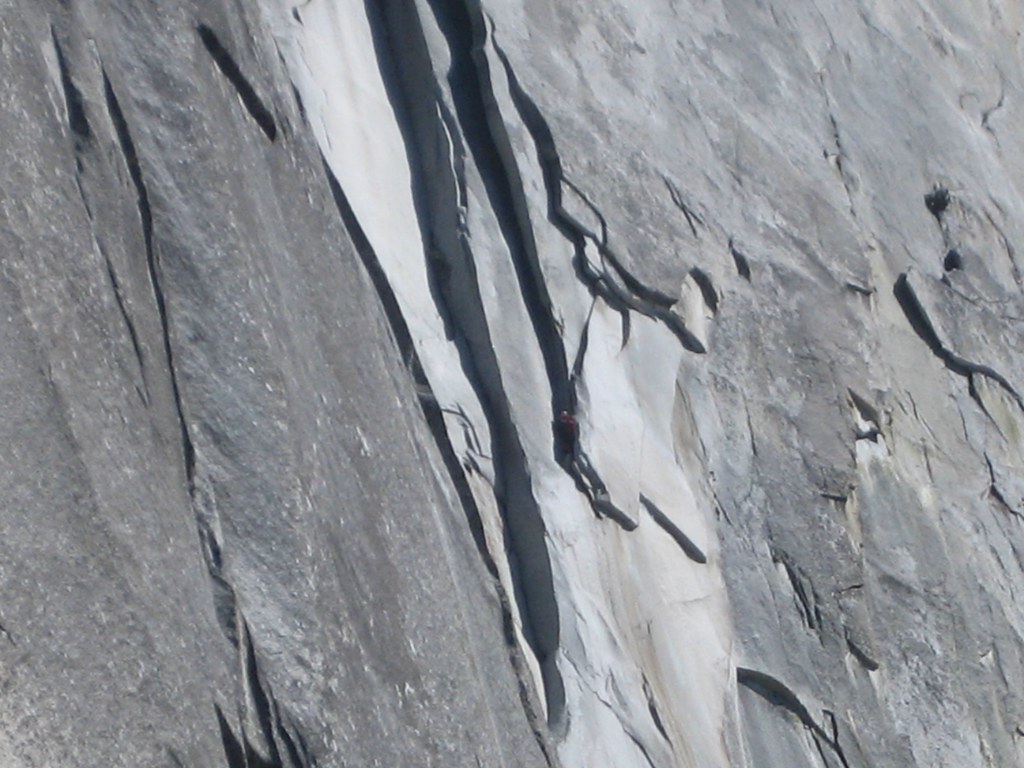
Further up, I could see the two climbers who’d started at 3am, now on Pitch 23 traversing the Thank God Ledge.
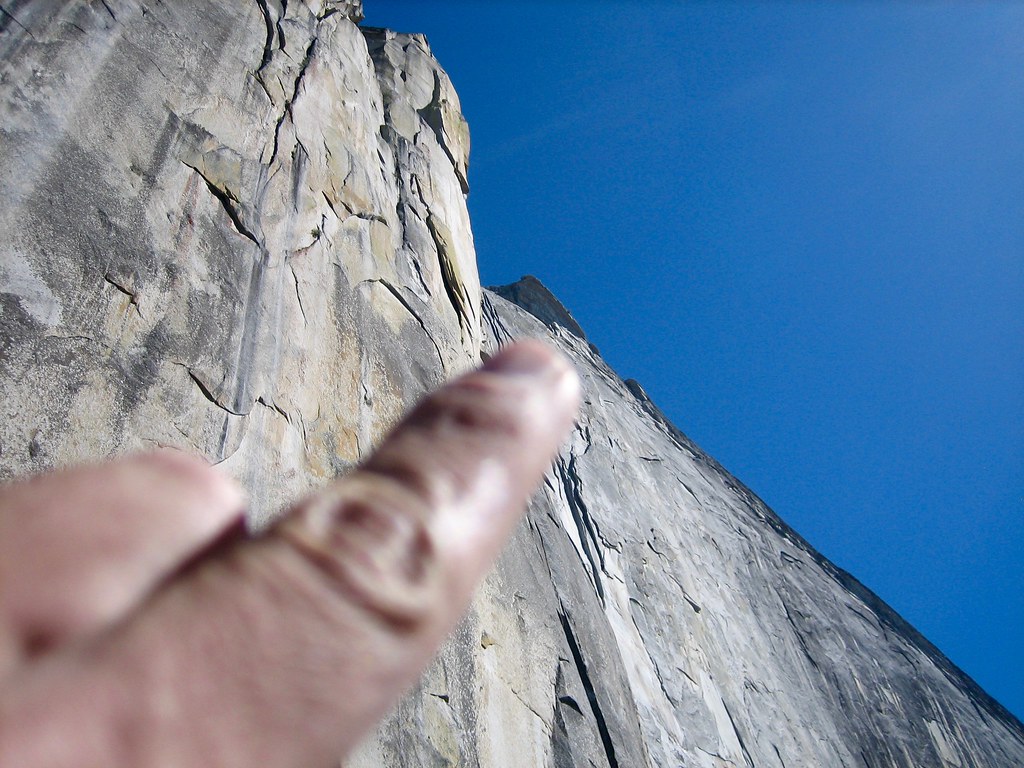
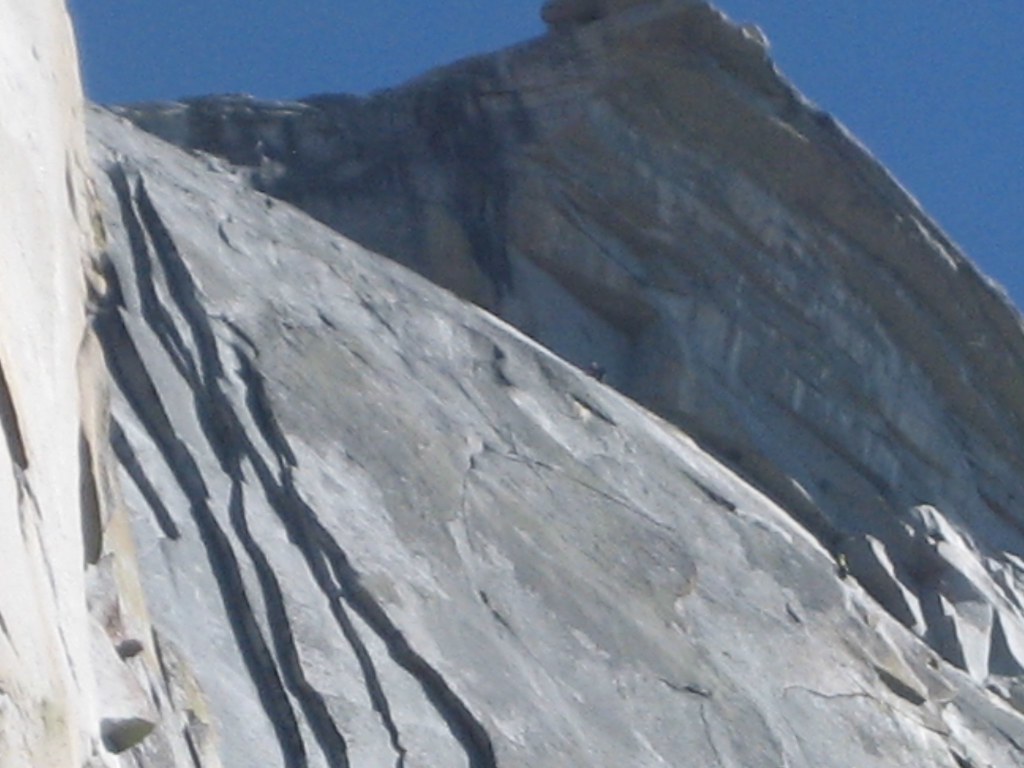
Before we could descend to the valley, we first had to hike up another 1,000 feet to reach the north shoulder of Half Dome, where we met the hiking trail. Here, we passed two climbers each weighted with gigantic backpacks (one of them looked like a 160-liter haul bag). They were headed where we’d just come from. Theirs was a totally different approach from what Jeff and I had tried with our pack-light-and-travel-fast-mentality.
We had 10 miles to dissect what had gone wrong for us on Half Dome. Was it the difficulty? The pace? The elevation for Jeff? The newness of the terrain? The 50lb weight on the leader? Could we have kept pushing, despite our slow pace, and simply stayed an extra night on the wall? Should we have opted for a haul bag rather than two backpacks? Were we simply not strong enough for Half Dome?
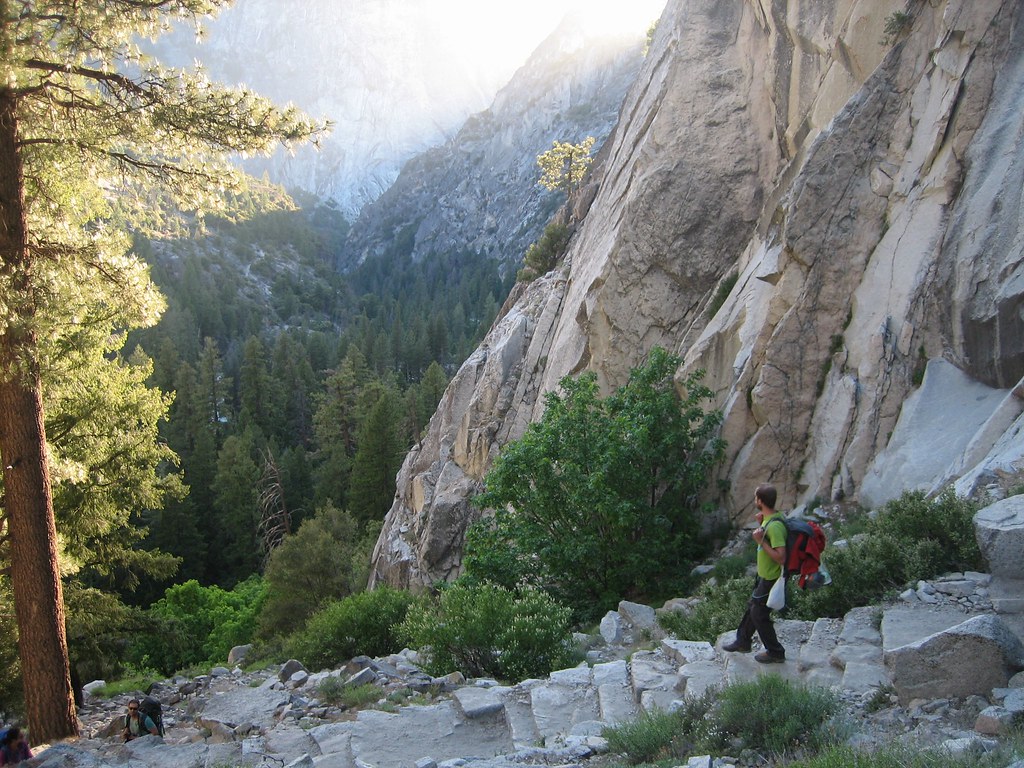
With each step, we mulled what-if scenarios as our horrible backpacks dug into our shoulder blades. The only solace was the scenery: snow-capped peaks in the distance, the 600-foot-tall Nevada Falls and 300-foot-tall Vernal Falls, and the setting sun’s eerie glow on the granite monoliths all around us.
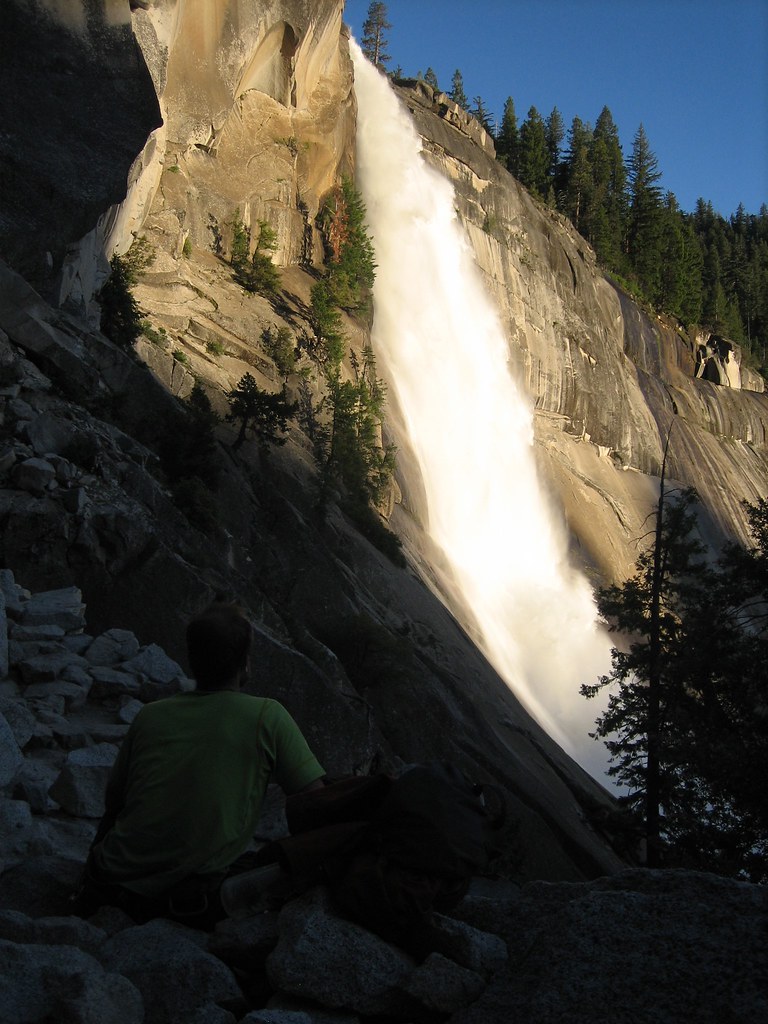
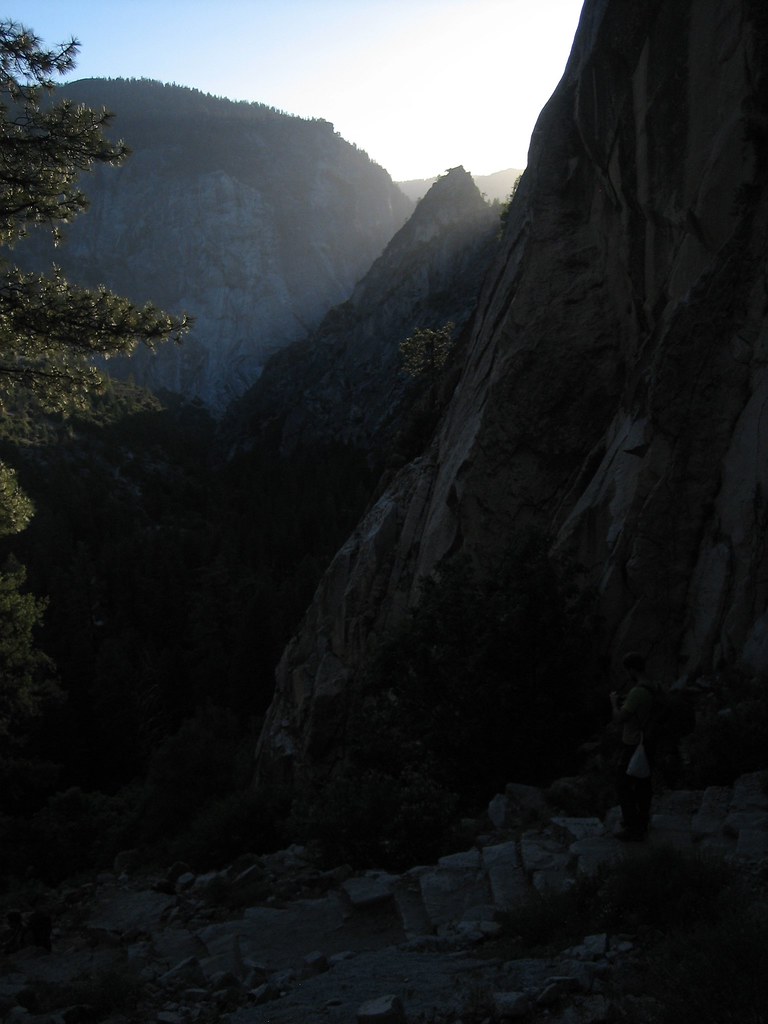
I also got some ego-boost from the coos of passing hikers, who looked wide-eyed at us with all our climbing gear.
“Did you climb Half Dome?” they’d ask.
“Yeah, I just climbed it,” I said, which was a half-truth — after all, I had climbed it. I just hadn’t finished it.
“Amazing!” they’d respond. “Awesome!”
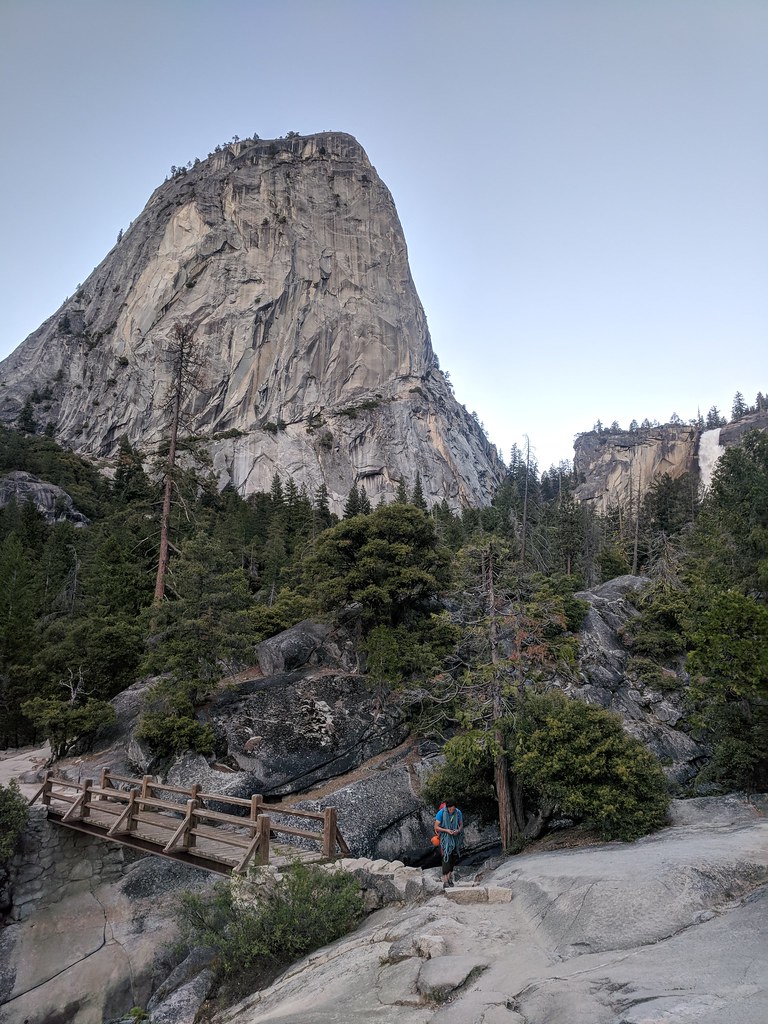
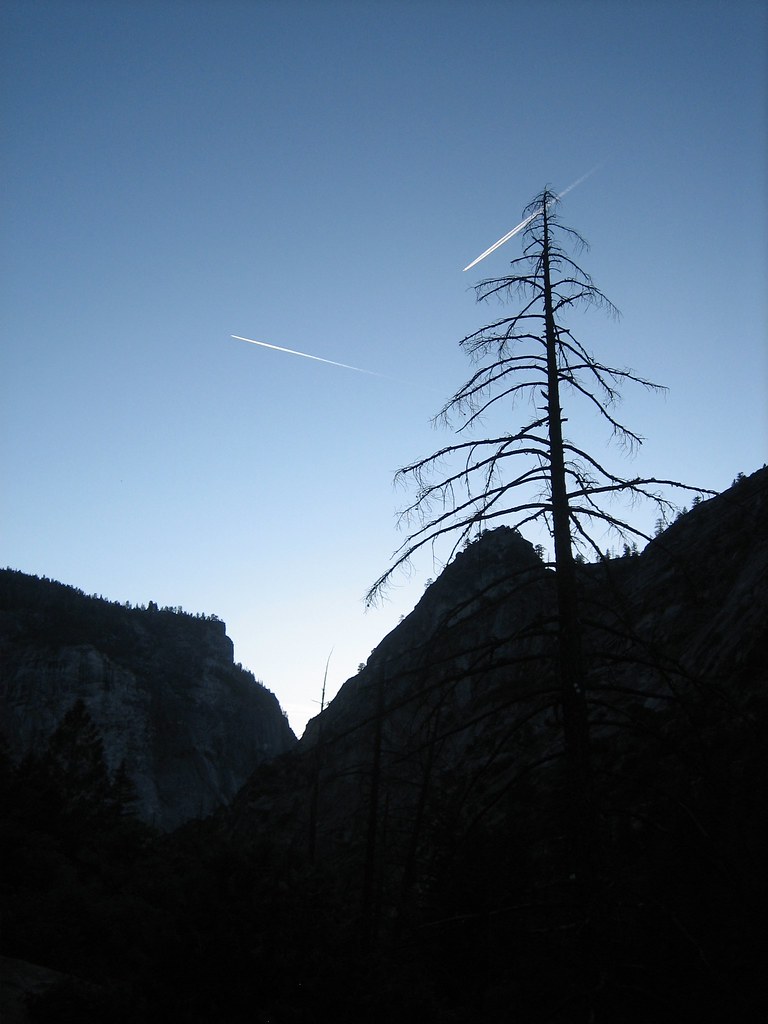
It was 9:30pm by the time we got back to our rental car. We found Greg’s campsite at Upper Pines — he’d generously offered to let us camp there, as our only other option would have been to sleep in the car or find a hotel outside the park. Dinner was two packages of freeze dried meals, plus crunchy Cheetos.
After eating, Jeff collapsed in the tent. It was about midnight. I was insistent on showering, my body being caked with two days worth of sweat and dirt accrued over 15 miles of hiking and 700 feet of climbing, so I walked a half-mile to Curry Village and found a public restroom with showers. The water stung the blisters on my feet.
I was finally asleep by 1am. As I settled into my warm sleeping bag on top of a comfy air mattress, I thought of Greg and Cameron somewhere on Half Dome. They’d departed that morning with only about 2 liters of water apiece — hardly enough for one day, let alone two. No doubt they were shivering, dehydrated, and hungry.
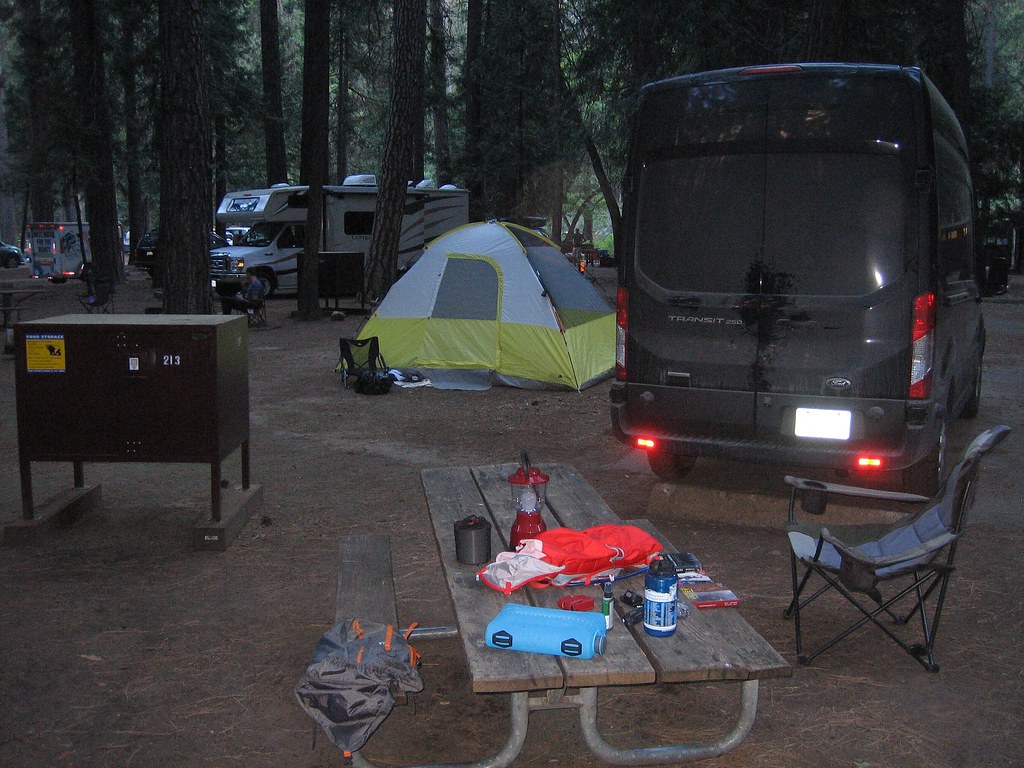
Chapter 5: The Rescue
The thunder of rescue helicopters flying overhead interrupted our morning coffee — three choppers in a row, all charging toward the northwest face of Half Dome, where we’d just been and where Greg and Cameron were now.
“Must be a rescue happening,” said Bill Wright, who was also camping on Greg’s site at Upper Pines. (All of Yosemite’s campsites are reserved within minutes every year, so it’s helpful to either have a friend or make a friend like Greg who has a site.) Bill had just been telling us about his friend who’d died days earlier in a speed-climbing accident on El Capitan, which had made the pages of The Washington Post and Outside.
Just then, Greg’s wife Kate pedaled into camp on her bicycle.
“Did you see the helicopters flying toward Half Dome?” Bill asked her.
“What?!” she cried.
Luckily, within minutes, Kate received a text message from Greg assuring that he and Cameron were fine and that the rescue was happening at the base of the route for another group of climbers. (For a sense of what a helicopter rescue looks like on Half Dome, see this video.)
Jeff and I exchanged looks that said, “Could that have happened to us if we hadn’t turned back?” All things considered, we felt we’d made the right decision. But while we’d lost our dream of scaling the northwest face, we still had three more days to climb in Yosemite. Looking for inspiration, we asked for recommendations from Bill, who turned out to be quite the authority.
Bill had co-authored the how-to book Speed Climb! with Hans Florine, who is regarded as one of today’s top climbers and who for a while held the speed ascent of the Nose of El Capitan (done with Alex Honnold). Bill and Hans had once done a 100-pitch day in Colorado’s Eldorado Canyon. Bill also claimed to be the coiner of the phrase Fastest Known Time, or F.K.T., which has become something of a cultural phenomenon worldwide led by the likes of Scott Jurek and Killian Jornet.
Understanding how much we wanted to climb Half Dome, Bill recommended an alternate route to the summit called Snake Dike. First climbed in 1965 by Jim Bridwell, one of the so-called Stonemasters of Yosemite in the 60s, Snake Dike is rated 5.7 but with an R, meaning that protection is scarce and the leader faces 80-foot-long runouts (which would mean a 150-foot fall). According to Climbing magazine:
The route takes its “R” rating mainly from the first pitch’s mandatory 80- foot runout off the deck to a 5.7 friction move beneath an L-shaped roof with dubious—if any—pro. (The testy third pitch is possibly the mental crux of the climb, with an exposed 5.7 friction traverse.)
Right away, I knew I wanted to climb Snake Dike. Jeff was less sold.
“I’m concerned about the run-outs,” he said later. He was likely also wondering whether I’d learned anything from the recent deaths on El Cap and climber rescues on Half Dome.
“I will lead every pitch,” I said, looking him in the eye with what I hoped was utter confidence and assurance. “I just need you to belay me.”
“OK,” he said.
For the remainder of the day, we rested and positively envisioned going from here on the valley floor:
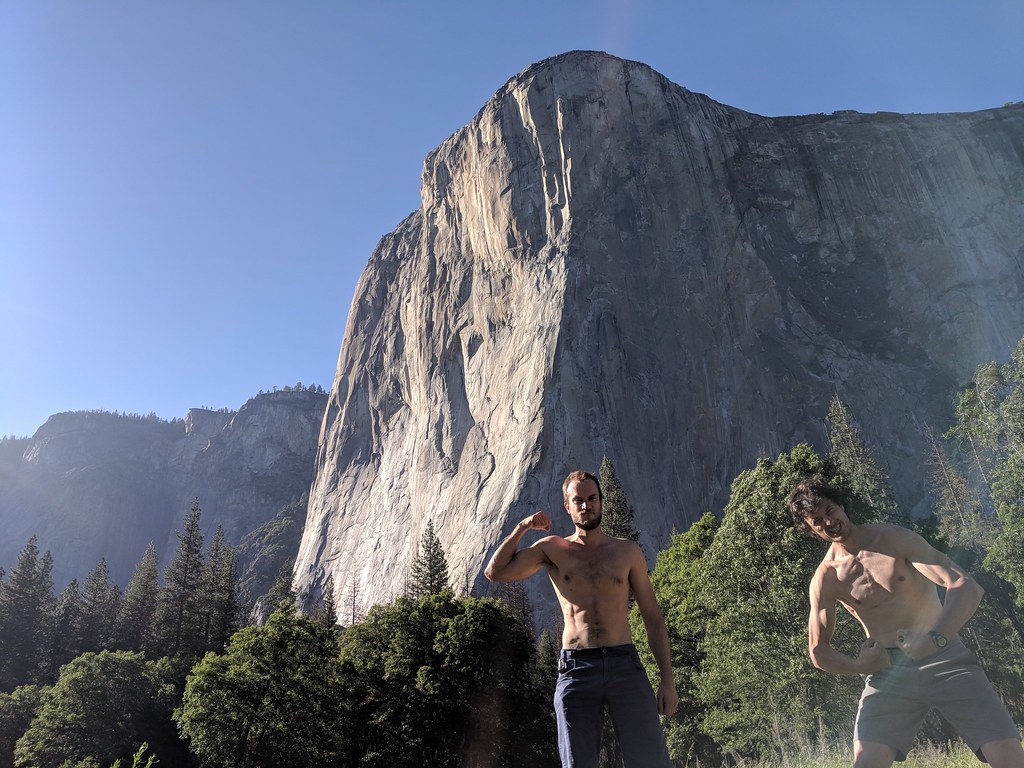
To here on the summit of Half Dome:
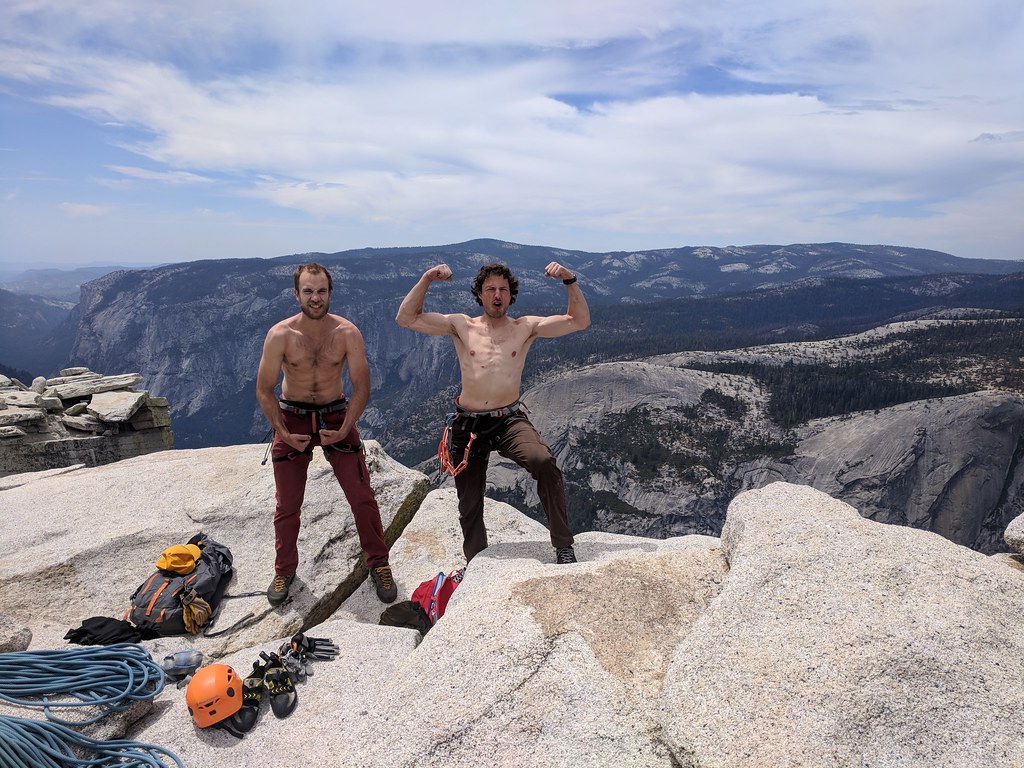
But where were Greg and Cameron? Just before Jeff and I hit the sack, the pair finally stumbled out of the darkness and into camp. They looked awful: haggard, parched, dirty, exhausted to the point of delirium. They were so dehydrated and tired that neither could stand without weaving sideways like a drunk.
“Nobody should have to endure that,” Greg said, in so many words. I offered him water from my jug, and he gladly dumped it down his throat. They’d survived on about 2 liters of water apiece over the previous 48 hours.
“So what’s you’re plan for tomorrow?” Greg asked me and Jeff.
“Snake Dike,” I said with a big smile.
“Good luck with that,” Greg said with a shake of his head, no doubt because he was not at all envious of our eight-mile-long and 4000-foot-elevation-gain approach to the base of the route, followed by a 1000-foot-climb and then a 1000-foot-scramble to the summit.
Greg and Cameron departed for a celebratory pizza, leaving me and Jeff to chat with Bill and his son Derek.
“How dangerous is Snake Dike, really?” I asked Bill. “I mean, I’m not going to die if I fall, am I?”
“You probably wouldn’t die, but you wouldn’t be walking away,” Bill said. “You’ll roll down Half Dome like you’re being ground over a cheese grater, and you’ll break a lot of bones.”
Not the send-off that I hoped to hear. Still, I was already in the mindset of total commitment to Snake Dike. I crawled into our tent and fell asleep quickly. But Jeff was rattled. He sat outside with his headlamp on, studying the route description. He couldn’t sleep, his mind turning over worst-case scenarios. My alarm was set for 3:45am.
